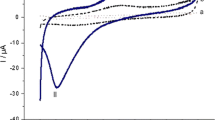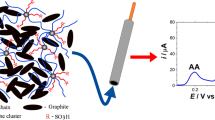Abstract
This paper describes a rapid and reliable method for dopamine (DA), ascorbic acid (AA), and uric acid (UA) determination in human urine using a cathodically pretreated poly(1-aminoanthraquinone) (PAAQ)-modified electrode. By applying a simple cathodic pretreatment to the PAAQ electrode well-defined voltammetric peaks for AA, DA, and UA were obtained. The pretreated PAAQ showed good selectivity, sensitivity, and repeatability for measuring AA, DA, and UA with detection limits of 2.50 × 10−5, 3.05 × 10−6, and 1.15 × 10−5 M, respectively. The practical applicability of the modified electrode is illustrated by selective measurements of AA and UA in human urine without any preliminary treatment. Recovery values between 94.8 and 102 % for AA and between 77.8 and 100 % for UA were obtained with a relative standard deviation of 2.74 and 2.98 %, respectively.






Similar content being viewed by others
References
Joseph MH, Young AMJ (1991) Pharmacological evidence, using in vivo dialysis, that substances additional to ascorbic-acid, uric-acid and homovanillic-acid contribute to the voltammetric signals obtained in unrestrained rats from chronically implanted carbon paste electrodes. J Neurosci Methods 36:209–218. doi:10.1016/0165-0270(91)90047-4
Oneill RD, Gonzalezmora JL, Boutelle MG, Ormonde DE, Lowry JP, Duff A, Fumero B, Fillenz M, Mas M (1991) Anomalously high-concentrations of brain extracellular uric-acid detected with chronically implanted probes—implications for in vivo sampling techniques. J Neurochem 57:22–29. doi:10.1111/j.1471-4159.1991.tb02094.x
Dursun Z, Gelmez B (2010) Simultaneous determination of ascorbic acid, dopamine and uric acid at Pt nanoparticles decorated multiwall carbon nanotubes modified GCE. Electroanalysis 22:1106–1114. doi:10.1002/elan.200900525
Njagi J, Chernov MM, Leiter JC, Andreescu S (2010) Amperometric detection of dopamine in vivo with an enzyme based carbon fiber microbiosensor. Anal Chem 82:989–996. doi:10.1021/ac9022605
Habibi B, Pournaghi-Azar MH (2010) Simultaneous determination of ascorbic acid, dopamine and uric acid by use of a MWCNT modified carbon-ceramic electrode and differential pulse voltammetry. Electrochim Acta 55:5492–5498. doi:10.1016/j.electacta.2010.04.052
Kim Y-R, Bong S, Kang Y-J, Yang Y, Mahajan RK, Kim JS, Kim H (2010) Electrochemical detection of dopamine in the presence of ascorbic acid using graphene modified electrodes. Biosens Bioelectron 25:2366–2369. doi:10.1016/j.bios.2010.02.031
Liu X, Peng Y, Qu X, Ai S, Han R, Zhu X (2011) Multi-walled carbon nanotube-chitosan/poly(amidoamine)/DNA nanocomposite modified gold electrode for determination of dopamine and uric acid under coexistence of ascorbic acid. J Electroanal Chem 654:72–78. doi:10.1016/j.jelechem.2011.01.024
Brunetti B, Desimoni E (2011) A new voltammetric sensor based on a glassy carbon electrode modified with 8-hydroxyquinoline-5-sulfonic acid. Electroanalysis 23:1116–1122. doi:10.1002/elan.201000601
Shi W, Liu C, Song Y, Lin N, Zhou S, Cai X (2012) An ascorbic acid amperometric sensor using over-oxidized polypyrrole and palladium nanoparticles composites. Biosens Bioelectron 38:100–106. doi:10.1016/j.bios.2012.05.004
Marti M, Fabregat G, Estrany F, Aleman C, Armelin E (2010) Nanostructured conducting polymer for dopamine detection. J Mater Chem 20:10652–10660. doi:10.1039/C0JM01364A
Sen Teker M, Tamer U, Pekmez NO (2012) Fabrication and characterization of poly(vinylferrocenium) perchlorate/poly(3,4-ethylenedioxythiophene) composite-coated electrode in methylene chloride. Synth Met 162:924–930. doi:10.1016/j.synthmet.2012.04.017
Troiani EP, Faria RC (2010) The influence of the cathodic pretreatment on the electrochemical detection of dopamine by poly(1-aminoanthracene) modified electrode. Electroanalysis 22:2284–2289. doi:10.1002/elan.201000225
Kalimuthu P, John SA (2009) Electropolymerized film of functionalized thiadiazole on glassy carbon electrode for the simultaneous determination of ascorbic acid, dopamine and uric acid. Bioelectrochemistry 77:13–18. doi:10.1016/j.bioelechem.2009.04.010
Kalimuthu P, John SA (2010) Simultaneous determination of ascorbic acid, dopamine, uric acid and xanthine using a nanostructured polymer film modified electrode. Talanta 80:1686–1691. doi:10.1016/j.talanta.2009.10.007
Ali SR, Parajuli RR, Balogun Y, Ma YF, He HX (2008) A nonoxidative electrochemical sensor based on a self-doped polyaniline/carbon nanotube composite for sensitive and selective detection of the neurotransmitter dopamine: a review. Sensors 8:8423–8452. doi:10.3390/s8128423
Atta NF, El-Kady MF (2009) Poly(3-methylthiophene)/palladium sub-micro-modified sensor electrode. Part II: Voltammetric and EIS studies, and analysis of catecholamine neurotransmitters, ascorbic acid and acetaminophen. Talanta 79:639–647. doi:10.1016/j.talanta.2009.04.040
Atta NF, El-Kady MF (2010) Novel poly(3-methylthiophene)/Pd, Pt nanoparticle sensor: Synthesis, characterization and its application to the simultaneous analysis of dopamine and ascorbic acid in biological fluids. Sens Actuators B 145:299–310. doi:10.1016/j.snb.2009.12.014
Santos A, Zucolotto V, Constantino C, Cunha H, dos Santos J, Eiras C (2007) Electroactive LbL films of metallic phthalocyanines and poly(o-methoxyaniline) for sensing. J Solid State Electrochem 11:1505–1510. doi:10.1007/s10008-007-0338-9
Stoyanova A, Tsakova V (2010) Copper-modified poly(3,4-ethylenedioxythiophene) layers for selective determination of dopamine in the presence of ascorbic acid: I. Role of the polymer layer thickness. J Solid State Electrochem 14:1947–1955. doi:10.1007/s10008-010-1007-y
Tiwari I, Singh KP, Singh M, Banks CE (2012) Polyaniline/polyacrylic acid/multi-walled carbon nanotube modified electrodes for sensing ascorbic acid. Anal Methods 4:118–124. doi:10.1039/c1ay05415e
Zucolotto V, Ferreira M, Cordeiro MR, Constantino CJL, Moreira WC, Oliveira ON (2006) Nanoscale processing of polyaniline and phthalocyanines for sensing applications. Sens Actuators B 113:809–815. doi:10.1016/j.snb.2005.03.114
D’Eramo F, Sereno LE, Arevalo AH (2006) Preparation, characterization and analytical applications of a new and novel electrically conducting polymer. Electroanalysis 18:1523–1530. doi:10.1016/j.materresbull.2004.10.014
Ghita M, Arrigan DWM (2004) Electrochemical overoxidation of polyindole and its cation-permselective behavior. Electroanalysis 16:979–987. doi:10.1002/elan.200302938
Li YX, Wang P, Wang L, Lin XQ (2007) Overoxidized polypyrrole film directed single-walled carbon nanotubes immobilization on glassy carbon electrode and its sensing applications. Biosens Bioelectron 22:3120–3125. doi:10.1016/j.bios.2007.02.001
Majidi MR, Asadpour-Zeynali K, Gholizadeh S (2009) Amperometric biosensor for dopamine determination based on over-oxidized polypyrrole-plant tissue composite. Int J Polym Anal Charact 14:89–101. doi:10.1016/j.colsurfb.2011.08.012
Silva QG, Troiani EP, Barbosa NV, Faria RC (2011) Electrochemical determination of norepinephrine on cathodically pretreated poly(1,5-diaminonaphthalene) modified electrode. Electroanalysis 23:1359–1364. doi:10.1002/elan.201100001
Martinez JG, Otero TF (2012) Biomimetic dual sensing-actuators: theoretical description. Sensing electrolyte concentration and driving current. J Phys Chem B 116:9223–9230. doi:10.1021/jp302931k
Otero TF (2009) Soft, wet, and reactive polymers. Sensing artificial muscles and conformational energy. J Mater Chem 19:681–689. doi:10.1039/b809485c
Otero TF, Grande H, Rodríguez J (1995) A new model for electrochemical oxidation of polypyrrole under conformational relaxation control. J Electroanal Chem 394:211–216. doi:10.1016/0022-0728(95)04033-K
Otero TF, Grande H-J, Rodríguez J (1997) Reinterpretation of polypyrrole electrochemistry after consideration of conformational relaxation processes. J Phys Chem B 101:3688–3697. doi:10.1021/jp9630277
Otero TF, Martinez JG, Arias-Pardilla J (2012) Biomimetic electrochemistry from conducting polymers. A review artificial muscles, smart membranes, smart drug delivery and computer/neuron interfaces. Electrochim Acta 84:112–128. doi:10.1016/j.electacta.2012.03.097
Badawy WA, Ismail KM, Medany SaS (2006) Optimization of the electropolymerization of 1-amino-9,10-anthraquinone conducting films from aqueous media. Electrochim Acta 51:6353–6360. doi:10.1016/j.electacta.2006.04.021
Otero TF, García de Otazo JM (2009) Polypyrrole oxidation: kinetic coefficients, activation energy and conformational energy. Synth Met 159:681–688. doi:10.1016/j.synthmet.2008.12.017
Xu XW, Lin QH, Liu AL, Chen W, Weng XH, Wang CL, Lin XH (2010) Simultaneous voltammetric determination of ascorbic acid, Dopamine and uric acid using polybromothymol blue film-modified glassy carbon electrode. Chem Pharm Bull 58:788–793
Mazloum-Ardakani M, Sheikh-Mohseni MA, Benvidi A (2011) Electropolymerization of thin film conducting polymer and its application for simultaneous determination of ascorbic acid, dopamine and uric acid. Electroanalysis 23:2822–2831. doi:10.1002/elan.201100289
Niu X, Yang W, Guo H, Ren J, Yang F, Gao J (2012) A novel and simple strategy for simultaneous determination of dopamine, uric acid and ascorbic acid based on the stacked graphene platelet nanofibers/ionic liquids/chitosan modified electrode. Talanta 99:984–988. doi:10.1016/j.talanta.2012.07.077
Zhu S, Li H, Niu W, Xu G (2009) Simultaneous electrochemical determination of uric acid, dopamine, and ascorbic acid at single-walled carbon nanohorn modified glassy carbon electrode. Biosens Bioelectron 25:940–943. doi:10.1016/j.bios.2009.08.022
Han D, Han T, Shan C, Ivaska A, Niu L (2010) Simultaneous determination of ascorbic acid, dopamine and uric acid with chitosan–graphene modified electrode. Electroanalysis 22:2001–2008. doi:10.1002/elan.201000094
Thiagarajan S, Chen SM (2007) Preparation and characterization of PtAu hybrid film modified electrodes and their use in simultaneous determination of dopamine, ascorbic acid and uric acid. Talanta 74:212–222. doi:10.1016/j.talanta.2007.05.049
Yu SJ, Luo CH, Wang LW, Peng H, Zhu ZQ (2013) Poly(3,4-ethylenedioxythiophene)-modified Ni/silicon microchannel plate electrode for the simultaneous determination of ascorbic acid, dopamine and uric acid. Analyst 138:1149–1155. doi:10.1039/c2an36335f
Acknowledgments
The authors acknowledge financial support from the Brazilian research funding agencies FAPESP, CNPq, and CAPES. The authors are also indebted to FAPESP (São Paulo State Research Funding Agency) for funding the Project (Proc. No. 08/06867-8).
Author information
Authors and Affiliations
Corresponding author
Rights and permissions
About this article
Cite this article
Troiani, E., Faria, R.C. Cathodically pretreated poly(1-aminoanthraquinone)-modified electrode for determination of ascorbic acid, dopamine, and uric acid. J Appl Electrochem 43, 919–926 (2013). https://doi.org/10.1007/s10800-013-0577-7
Received:
Accepted:
Published:
Issue Date:
DOI: https://doi.org/10.1007/s10800-013-0577-7




